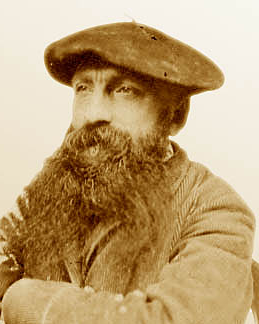|
RODIN
(roh-DAN)
French
sculptor of major importance
Common
clues: “The Kiss” sculptor; “The Gates of Hell”
sculptor; “The Age of Bronze” artist; “The
Thinker" sculptor; French sculptor Auguste
Crossword
puzzle frequency:
once a year
Frequency
in English language:
33348 / 86800
Video:
Rodin
Sculpture
Auguste
Rodin (born François-Auguste-René Rodin; November
12, 1840–November 17, 1917) was a French artist, most
famous as a sculptor. He was the preeminent French sculptor of
his time, and remains one of the few sculptors widely recognized
outside the visual arts community.

Although
Rodin is generally considered the progenitor of modern sculpture,
he did not set out to rebel against the past. He was schooled
traditionally, took a craftsman-like approach to his work, and
desired academic recognition, although he was never accepted into
Paris's foremost school of art. Sculpturally, he possessed a
unique ability to model a complex, turbulent, deeply pocketed
surface in clay.
Many
of Rodin's most notable sculptures were roundly criticized during
his lifetime. They clashed with the predominant figure sculpture
tradition, in which works were decorative, formulaic, or highly
thematic. Rodin's most original work departed from traditional
themes of mythology and allegory, modeled the human body with
realism, and celebrated individual character and physicality.
Rodin was sensitive to the controversy about his work, but did
not change his style, and successive works brought increasing
favor from the government and the artistic community.
During
his lifetime, Rodin was compared to Michelangelo, and was widely
recognized as the greatest artist of the era. In the three
decades following his death, his popularity waned with changing
aesthetic values.[63] Since the 1950s, Rodin's reputation has
re-ascended; he is recognized as the most important sculptor of
the modern era, and has been the subject of much scholarly work.
The sense of incompletion offered by some of his sculpture, such
as The Walking Man, influenced the increasingly abstract
sculptural forms of the twentieth century. Though highly honoured
for his artistic accomplishments, Rodin did not spawn a
significant, lasting school of followers. His notable students
included Antoine Bourdelle, Charles Despiau, the American Malvina
Hoffman, and his mistress Camille Claudel, whose sculpture
received praise in France. The French order Légion
d'honneur made him a Commander, and he received an honorary
doctorate from the University of Oxford.

Rodin
restored an ancient role of sculpture—to capture the
physical and intellectual force of the human subject—and he
freed sculpture from the repetition of traditional patterns,
providing the foundation for greater experimentation in the
twentieth century. His popularity is ascribed to his
emotion-laden representations of ordinary men and women—to
his ability to find the beauty and pathos in the human animal.
His most popular works, such as The Kiss and The Thinker, are
widely used outside the fine arts as symbols of human emotion and
character.
This
article is licensed under the GNU
Free Documentation License.
It uses material from the Wikipedia
article "Rodin".
RODIN
(68) 17
Tu- >1 04 "The Thinker" sculptor
14
We- >1 09 "The Kiss" sculptor
5
Fr- >1 08 "The Gates of Hell" sculptor
5
Mo+ >1 97 "The Thinker" creator
4
Th+ >1 00 "The Age of Bronze" sculptor
3
Th- >1 08 "The Age of Bronze" artist
1
Th NYT 02 "Eternal Spring" sculptor
1
Th NYT 87 "Le Baiser" sculptor
1
Th NYT 96 "Le Penseur" sculptor
1
Th LAT 99 "The Age of Bronze" creator
1
Th WSJ 08 "The Burghers of Calais" creator
1
Th NYT 96 "The Burghers of Calais" sculptor
01
"Walking Man" sculptor
1
Th CHE 06 'The Kiss' sculptor
1
Mo NYS 03 'The Thinker' sculptor
1
We NYT 95 Balzac sculptor
00
Bartholdi contemporary
1
Tu NYT 57 Famous sculptor
00
French sculptor
1
Mo NYS 04 French sculptor Auguste
1
Sa NYT 06 He made a bust of Mahler
1
Fr NYT 87 He sculpted "The Thinker"
1
We NYT 87 He sculpted G.B.S.
1
Th NYT 83 He thought up "The Thinker"
1
Th LAT 02 Sculptor Auguste
|